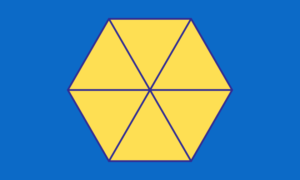At the beginning of the class there was a focus conversation about Pre-Internship. I personally have not gotten to the point in my schooling journey to be in my 3 week block yet. I have been taking a full class load, while taking multiple spring classes- I wanted to take this class now (at the end of my 2 & 1⁄2 year of University) to make it easier on myself when I am in my semesters of Interning. This was nice to still be a part of in the sense I was able to get an idea of what some of my peers experienced during their time in their internship. We did a PollGuru to facilitate conversations and opinions of what was seen in everyones classrooms during their experiences. This was a beautiful way of fitting all the pieces of assessment into a whole! Which leads me to my symbol this week.
This week my symbol is the yellow Hexagon used while teaching fractions to represent a whole. The idea that this Hexagon can be separated into different fractions- all that can add up to be a whole and construct different pieces of an idea. Some pieces of assessment use COPS- as was mentioned in the class on Wednesday, “Conversation, Observations, Products” each represent ⅓ of putting together parts of assessment to make a successful whole.
We also went over the Class Community Summary Score Sheet for our Dialogue Papers. There are also three points that make up this form of assessment- There were the scores, the Range, and the Mean. This made up my Dialogue Papers fraction. I found it to be an enlightening process as well. I got a better understanding of how my peers like to assess and understand what I wrote- it meant different things to different people, which I wholeheartedly respect.
Another task we went over was the Fraction activity. In itself it represents my fraction symbol, however, this activity had multiple pieces making it a whole. I was able to complete the Fraction activity a couple of weeks ago, then myself and a peer came together to decide how we would assess those who have completed the activity (what question is worth what points and what category they land under: Intellectual, physical, or Spiritual), finally we looked at how the Fraction activity is marked and what category each question falls into. This helps to make us look at data in a thoughtful way!
Overall, this class helped to make some more pieces of the fraction for Assessing and learning easier!
Best Baylee

